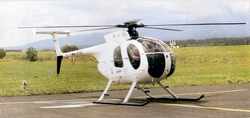Wed, Aug 21, 2013
Helicopter Long Line Was Hoisting Two Workers When It Severed
The NTSB has released a preliminary report from an accident involving a Hughes 369D helicopter that fatally injured two utility workers employed by Wind Energy Transmission of Texas.

According to the report, on August 5, 2013, at 0915 central daylight time, a Hughes model 369D helicopter, N8688F, was not damaged when its external cargo long-line was severed after colliding with a shield wire suspended between power transmission towers near Ackerly, Texas. The two linemen who were being hoisted on the long-line were fatally injured after falling about 200 feet to the ground after the collision. The helicopter was registered to and operated by Haverfield Aviation Inc., under the provisions of 14 Code of Federal Regulations Part 133 as an external load flight, without a flight plan. Day visual meteorological conditions prevailed for the local flight, which was operating from a landing zone situated near the accident site.
According to the operator, the helicopter was equipped with a 100-foot long external cargo long-line that was being used to hoist linemen onto power transmission towers. Shortly after departure, as the helicopter was climbing toward the transmission tower, the long-line collided with a shield wire suspended between transmission towers. The operator reported that the long-line severed about 5 feet above the linemen. The pilot returned to the landing zone and made an uneventful landing. The pilot did not report any malfunction or failures with the helicopter that would have prevented normal operation.
The nearest aviation weather reporting station was located at Big Spring McMahon-Wrinkle Airport (KBPG), Big Spring, Texas, about 20 miles southeast of the accident site. At 0915, the KBPG automated surface observing system reported: wind from 160 degrees at 11 knots, visibility 10 miles, sky clear, temperature 28 degrees Celsius, dew point 16 degrees Celsius, and an altimeter setting of 30.10 inches of mercury.
(Similar helicopter pictured in file photo. Not accident aircraft)
More News
Takeoff Roll The process whereby an aircraft is aligned with the runway centerline and the aircraft is moving with the intent to take off. For helicopters, this pertains to the act>[...]
“We’re proud of the hard work that went into receiving this validation, and it will be a welcome relief to our customers in the European Union. We couldn’t be mor>[...]
"Aircraft Spruce is pleased to announce the acquisition of the parts distribution operations of Wag-Aero. Wag-Aero was founded in the 1960’s by Dick and Bobbie Wagner in the >[...]
IDENT Feature The special feature in the Air Traffic Control Radar Beacon System (ATCRBS) equipment. It is used to immediately distinguish one displayed beacon target from other be>[...]
Aero Linx: Pararescue Air Force Pararescuemen, also known as PJs, are the only DoD elite combat forces specifically organized, trained, equipped, and postured to conduct full spect>[...]
 ANN's Daily Aero-Term (05.10.24): Takeoff Roll
ANN's Daily Aero-Term (05.10.24): Takeoff Roll Aero-News: Quote of the Day (05.10.24)
Aero-News: Quote of the Day (05.10.24) Aero-News: Quote of the Day (05.11.24)
Aero-News: Quote of the Day (05.11.24) ANN's Daily Aero-Term (05.11.24): IDENT Feature
ANN's Daily Aero-Term (05.11.24): IDENT Feature ANN's Daily Aero-Linx (05.11.24)
ANN's Daily Aero-Linx (05.11.24)



